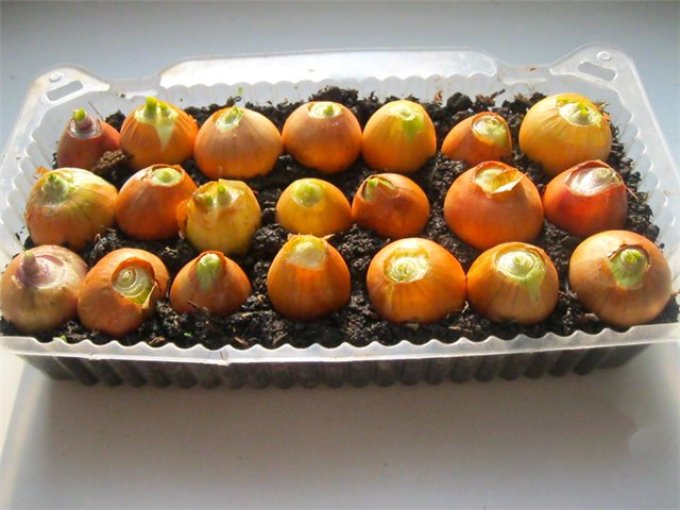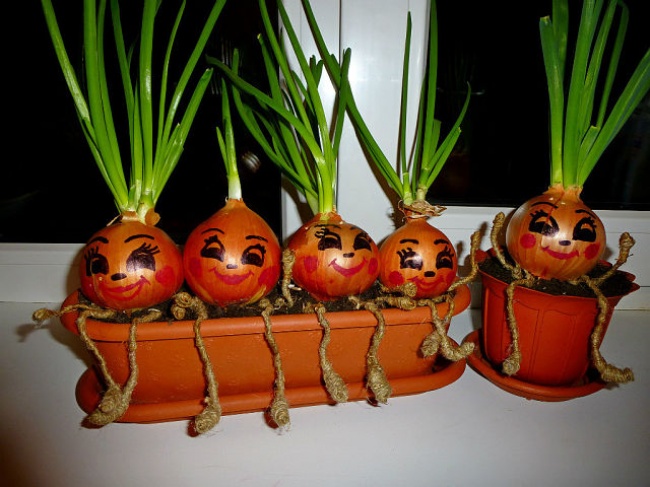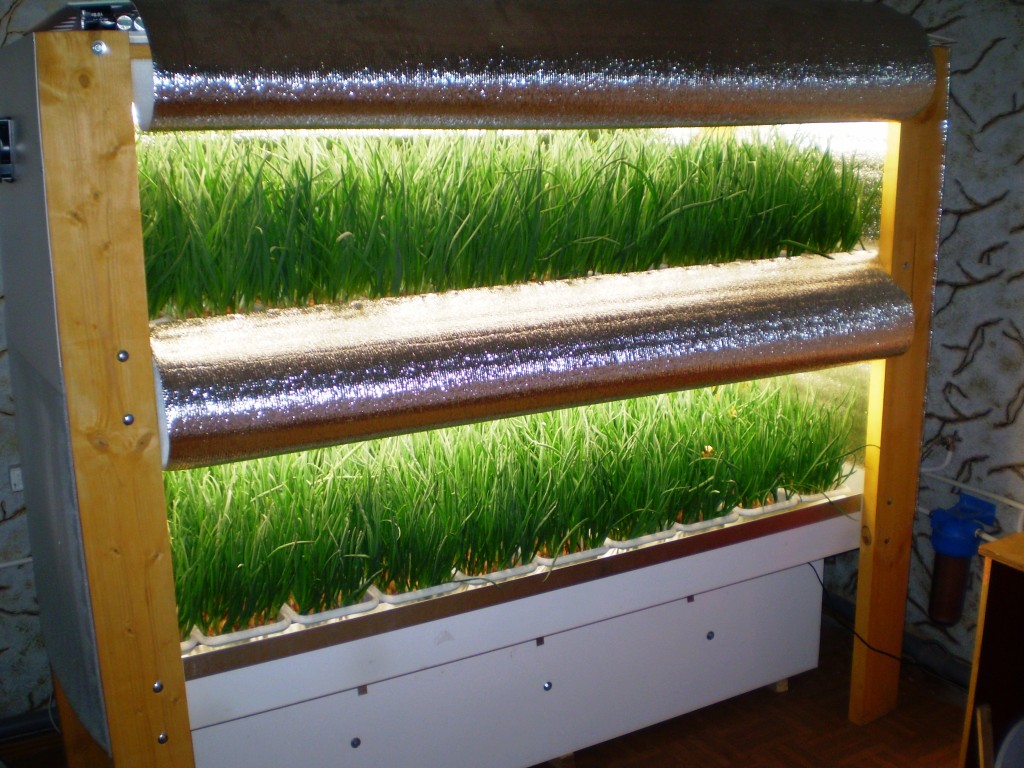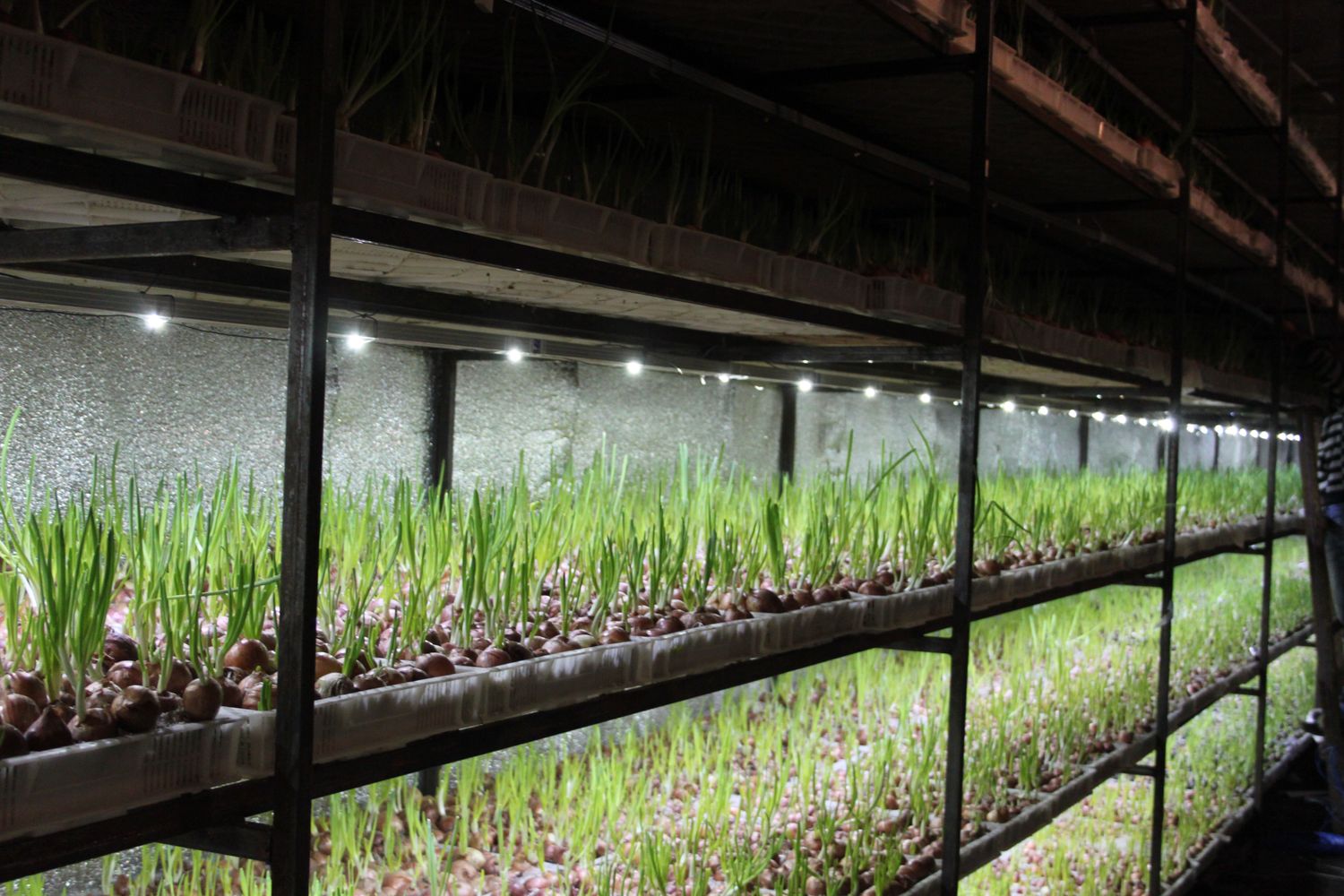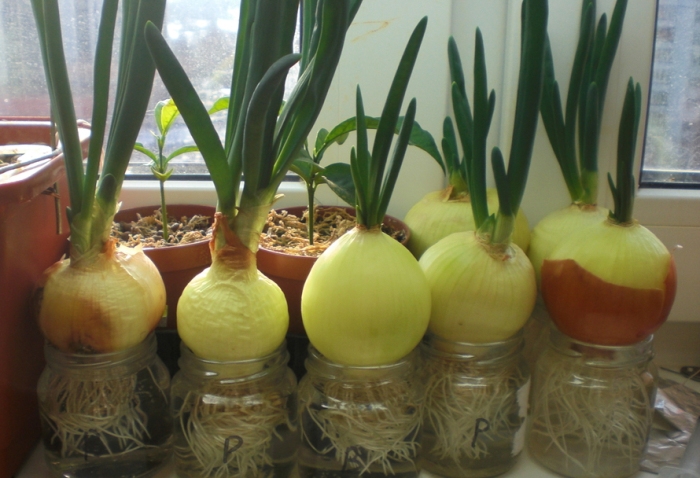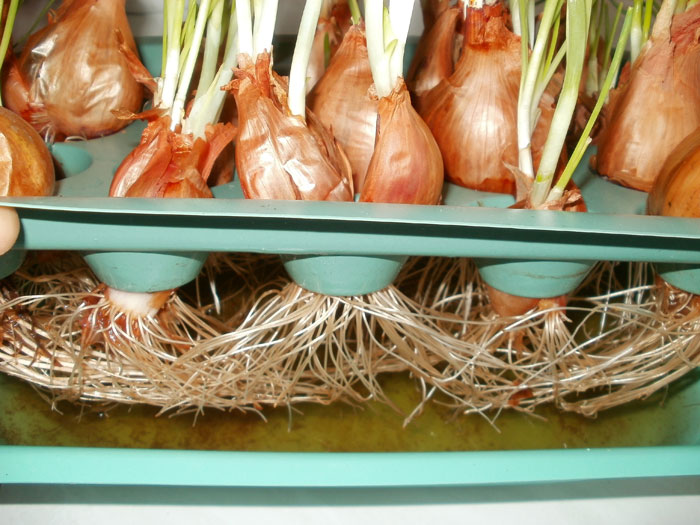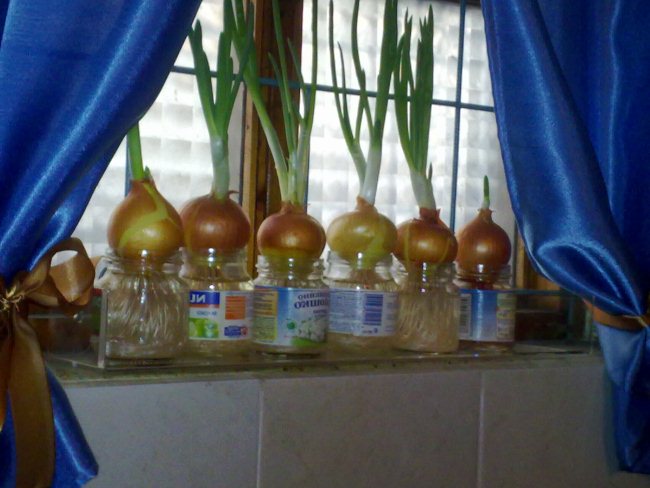How to germinate onions on the windowsill in water. Other business ideas. Growing onions for greens in open ground.
Onions - one of the few plants that are used in the course "and tops, and roots." In addition to its culinary qualities, onions have healing properties and is widely used not only in cooking, but also in traditional medicine.
Due to its ability to tolerate low temperatures, the cultivation of onions at home has long ceased to be the prerogative of only the southern regions. But, despite the prevalence and popularity, onions are picky about growing conditions and have many “detractors” capable of significantly spoiling the yield.
Growing onions at home: the choice of planting material
Onion is biennial plant. For the cultivation of bulbs use seeds. When planting a ripe bulb on next year You can get a new seed.
For ripening onions required long warm period. Therefore grow onion from seeds obtained only in the southern regions. For the middle band, a more acceptable way to produce bulbs in two years. At the same time, in the first year, onions are grown from seeds, and already from it for the next season they get a decent harvest of onions during plantings.
Onions are grown not only for bulbs, but also for greens. The choice of onion planting material for growing at home depends, above all, from landing targets.
Choosing onion seeds
Choosing onion seeds, you need to focus on the varietal quality of planting material. Today, 357 varieties of various onions are registered, of which 199 are bulb onions. Of course, it is easy to get lost in this variety. But remember that best harvest can be obtained only from zoned varieties. Bow sharply reacts to the length of daylight, temperature indicators. Therefore, sweet varieties of onions are grown only in the south. In more northern regions, onions are cultivated with a semi-sharp and spicy taste.
Choosing a bow set
Onion sets fervent gardeners try to grow on their own, which allows you to significantly save on planting material and be confident in its quality. When buying onions on the market or in a store, pay attention to both its appearance and size.
Instead of an onion set, enterprising merchants may sell small, rejected two-year-old onions that are unsuitable for good yields. Also, the quality of the bulbs affects the storage temperature. If sevok was stored at low temperatures less than +5 C, it can go into arrows instead of good bulbs.
Onion sets are divided into categories, depending on its size:
Ovusjug - the smallest, refers to a non-standard and has a diameter of less than 1.0 cm;
Samples - the largest planting material and has a diameter greater than 3 cm.
Onion sets for planting
You can decide on the size of planting bulbs, adhering to the rules:
1. For a podzimny landing, they take an overstock for onions - it does not stay until spring and can dry out.
2. In the fall and in the spring, the first category is planted; the best onion is produced from it.
3. For the forcing of the green pen, onions more than 1.5 cm will fit, these include sets of the second category and samples.
Planting Onions check for the presence of mold, elongated tails, rotted roots. Such material is immediately rejected, not only the harvest will not work out of it, but diseases can also be brought into your own garden.
It is advisable to cut a few onions. This will allow you to see the number of ovaries. For onions, good material with one seed share. But for abundant greenery it is better to choose sets with a large number of buds.
How to grow onions in the greenhouse at home?
At home, there is a great opportunity to grow onions year-round. To do this, it is planted in greenhouses. Greenhouse conditions are good for forcing a bow on a green feather. Cultivation conditions depend on the type of greenhouse and the possibilities of its heating.
Growing onions at home in cold greenhouses
Greenhouses, which do not provide additional heating, are suitable for dim onion planting. This approach allows the use of land in the greenhouse efficiently. By removing onion plantations in early spring, other crops can be planted at the same place.
Soil preparation. We begin to prepare the soil for growing onions at home in advance. To do this, before digging the beds, we apply fertilizer. You can apply the manure, as well as a mixture of 30 grams. superphosphate with the addition of 15 grams. potassium chloride per 1 m2. The soil is carefully digged and leveled.
Planting bulbs. We begin planting bulbs in October, before the onset of frost, so that they can take root, but not grow. The row spacing for onion planting is 2-2.5 cm. The depth of planting is not more than 4 cm.
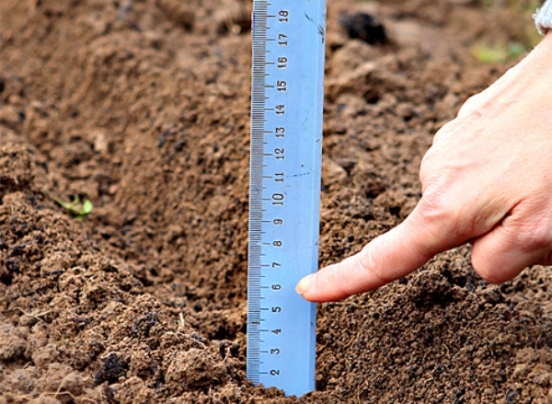
We control the depth of the onion
Beds, planted with seed harboring any natural insulation, the layer of which should be about 3 cm. With the onset of frost, we increase the layer of insulation to 20 cm.
Care. In March we clean the onion beds from snow and insulation. We install protective film constructions. Further care provides for abundant watering, taking into account the drying of the earth, as well as dressing. For fertilizer use urea at the rate of 15 grams. per square meter.
Harvesting. Already in late April, you can start harvesting. When the feather reaches 20 cm, onion greens are collected together with onions.
Growing onions at home in heated greenhouses
Having a good greenhouse with glazing or polycarbonate, you can do year-round cultivation of onions at home. But for this you will need additional heating and lighting.
Soil preparation. To save space and ease of care better bow land not in the ground, but in prepared boxes or boxes. In this case, they can be installed in several tiers. Tara fill with land from the garden or peat. Before planting, pour the ground with warm water to warm it up.
Planting bulbs. To distill the onions in the greenhouse, take a seedling onion, the optimal diameter of which is more than 3 cm. To accelerate growth, we warm the bulbs at a temperature of about 400 C. We cut the neck of the bulbs and place them in boxes tightly to each other. It is not necessary to deeply deepen the onions into the soil.
Care. After planting, we lay the ground for four days with sacking, this will allow us to warm the plantings and to start growing bulbs faster. Further care is provided for permanent watering and fertilizing with nitrogen fertilizer.
Favorable temperature conditions for the growth of onions in the greenhouse is supported by controlled heating and should be:
During the day: 18-200 C;
At night: 12-150 C.
You can start harvesting already in a month. For what the green feather is cut off or the plantings are removed completely.
Growing onions from seeds at home
Growing onions from seeds is a bit more complicated than from onion sets. The process requires a longer time. Therefore, seed cultivation is often used to produce onion sets. If it is decided, nevertheless, to harvest the onion from seeds in one season, you can use one of three options:
Sow seeds in the ground before winter;
Apply spring planting in open ground;
Grow onions with seedlings.
Landing dates are different in each case:
1. Spring work on the cutting of Chernushka is carried out immediately after thawing of the soil. Only in this case will the bulbs have time to ripen before the onset of cold weather.
2. Seedlings begin to cook in late February. Grown up plants are planted in the ground with the onset of warm days in April.
3. Sowing of seeds in the autumn is carried out on the frozen soil. In this case, they will not have time to grow to stable frosts, and with the first warm days they will immediately start growing.
Regardless of the method of growing onions at home from seed, we prepare the beds in advance. To this end, we dig them up in the fall and add mineral fertilizers in the form of urea or organic matter such as compost or peat to the ground. Bow - loves warmth and good lighting. Therefore, onion beds should be located on the lighted areas, but avoiding drafts.
Predecessors for onion plantings - These are tomatoes, potatoes, cucumbers. But in one place it is better not to plant a bow, but to return it to the landing site no earlier than four years later. Compliance with crop rotation will prevent diseases and improve yields.
Seed preparation for planting
Further germination rate and quality of the crop depends on the correctness of seed preparation. This stage should be given due attention:
1. Check seed germination. To do this, take up to 20 seeds and maintain them for up to three weeks on a damp cloth. The number of samples that should be at least 80% will tell about good germination.
2. It is possible to destroy the causative agents of fungal diseases by treating the seeds with potassium permanganate.
3. To accelerate germination, soak the seeds in warm water for up to 18 hours.
4. Stimulants will help to improve fruit production, which are added when soaking at the rate of 1 oz. on a spoon.
5. Before sowing, seeds are removed from the water and dried. In 20 minutes the moisture will evaporate and the seeds will become loose and suitable for planting.
After the preparatory work has been done, you can start sowing nagging.
Ground sowing
As soon as the snow melts and the soil thaws, you can begin to work. We make rows on beds prepared from autumn, the depth of which should not exceed 2 cm. We provide a distance of up to 20 cm between the beds. Dust the seeds with chalk, you can use tooth powder. So it will be easier to control the location of the seeds. We sow chernushka quite sparse, at the rate of 80 seeds per meter.
For sprinkling over seeds We use organic matter in the form of humus, sawdust or peat. The layer should not be more than 2 cm. Immediately after planting the seeds, do not water the beds. A crust may appear, which will prevent the weak shoots from hatching.
When two true leaves appear, proceed to thinning. Remove weak sprouts. Stronger gently transplant to new beds, using as seedlings. The distance between shoots leave up to 2 cm.
Second thinning provided with the appearance of 4 sheets. In this case, we expand the distance to 5 cm. And we use the torn shoots for food.
Onion loves moisture. Therefore, do not let the soil dry out. Water the onions when grown at home regularly until mid-July. But do not overdo it. With an excess of moisture can begin to rot bulbs and infection multiply. During the season, fertilize the onions twice with nitrogen mixtures.
We start harvesting at the beginning or in the middle of September, when all the leaves will fall down completely. The crop needs to be dried. This can be done directly on the beds or in another dry place under a canopy.
Growing seedlings from onion seeds at home
Extend the growing season, as well as significantly save planting material can be sown chernushku seedlings. For this work begin to carry out in early March. Seedlings can be grown both in the greenhouse and in the house.
The boxes are filled with soil mixture, which is mixed with peat or fertilized with superphosphate with potassium chloride. We sow the planting material prepared according to the above scheme in boxes in rows, between which we provide a distance of up to 5 cm.
Before the emergence of shoots, we maintain the temperature not lower than +250 C. With the appearance of the first shoots, we reduce the temperature during the day to +120 C, and at night to +80 C. After four days we create the optimum temperature for growing onions at home, which ranges from +15 - + 180 C. To extend the daylight using fluorescent lamps.
We plant seedlings in the ground at the end of April, when 4 true leaves with a height of 15 cm have been formed on the plants. When transplanting in the garden, we remove feathers by a third of the length, and roots are up to 2 cm.
In the beds, seedlings are planted after five centimeters. After a couple of days, we water the planted seedlings and gently loosen the ground.
Growing onions on a feather at home
Green onion feathers can be grown in beds and greenhouses, as well as in a city apartment. Home cultivation of onions on a feather is possible even in winter conditions, for which it is planted in boxes with earth or simply sprouted in containers with water.
Feather can be obtained not only from onions.
Conveniently for receiving greens grow perennial varieties of onions, which include:
Onions batun;
Onion slizun;
Chives;
Tiered bow.
Good greens are obtained from varietal onions such as shallots, Armazansky, Bessonovsky, Rostov, Amber varieties of onions.
Planting is carried out as seed material, and onions. For good greens choose bulbous, having several ovaries.
Onion greens are quite demanding for lighting. Therefore, place the beds on the open areas, and in greenhouses and apartments, if necessary, use additional lighting.
There are no special requirements for the soil when growing onions at home on the pen. But you can feed it before planting manure or mineral nitrogen fertilizers.
Planting onions in the ground begin after the soil warms up in April, and the sub-winter planting takes place in October before the onset of frost.
If onions are grown from seeds for greens, planting is done on frozen soil.
Onion planting can be done in two ways:
1. The bridge method provides a dense arrangement of heads that are sprinkled on top with earth or peat.
2. When the ribbon method, the bulbs are planted in the grooves. Between them, the distance must be at least 4 cm.
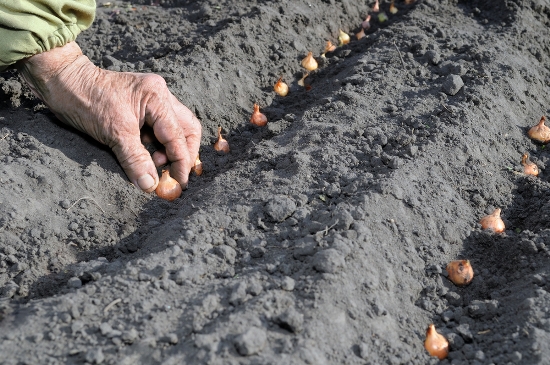
Ribbon method of landing onions
During the growing season, green onions are constantly watered, avoiding drying out. With a lack of moisture, feathers begin to fade. Top dressing needs to be made after green cutting. This will allow the bulbs to loosen and give a new crop. To do this, use urea or nitromafosku.
Also constantly loosen the soil. This will saturate the soil with air. And timely removal of weeds will prevent the development of diseases and soil depletion.
How to deal with pests when growing onions?
Many pests can significantly damage a crop or even destroy it:
Onion fly. Insect is activated in spring, laying the larvae near the onion beds or directly on the onion. The larvae move into the flesh and destroy the plant. At the same time the leaves wither, and the fruit begins to rot and smell unpleasant.

Onion damaged by onion fly
Onion moth. The best conditions for its development is hot and dry weather. The larvae feed on the onion juice from the leaves, where they are laid by adult individuals.
Root Tick. Destroys root system, both during the growing season and during storage. Bulbs fade and crumble.
Onion behind the scenes. These are small bugs that burrow into the pulp of the bulbs, making grooves and passages.
To control pests, use not only chemicals, but also simple cultivation guidelines and popular recipes:
1. Observe crop rotation, not planting bulbous in one place.
2. Before planting seed in the form of onion sets soak in saline. It will deter pests.
3. Saline solutions can be watered beds, when insects in the spring lay larvae.
4. Loosen the soil in a timely manner. Insects and larvae find it harder to move on loose soil.
5. Remove weeds. They are a breeding ground for harmful organisms.
6. Rake the ground from the onion necks. Thus, it is possible to create difficulties for the laying of larvae.
7. Plant carrots next to onions. Onion fly does not tolerate its smell.
Copper sulfate can be used for soil disinfection, from which a solution is prepared (25-30 grams per bucket of water). During mass shoots onion sprayed bordeaux mixture. This helps to get rid not only of pests, but also from fungal diseases.
You can use biological preparations of the type. Fitoverma, Agrovertinasprayed plants several times during the season.
Onions are subject to fungal diseases in the form of:
. resuscitation (downy mildew), spreading through the foliage in the form of light, turning into brown spots;
. rustwhich completely makes the foliage dry out;
. fusariumaffecting the root system.
In the fight against fungal diseases use the same preventive measures as pests. Of the drugs, you can try to handle the landing Gliokladinom, Fitosporin-M, Alirin, Gamar.
Biological preparations do not accumulate in the onion and can be used for consumption in two days.
Pay enough attention to the onion plantings, loosen and water, feed and destroy the pests and there will always be fresh greens on your table, and in the closet winter stocks of onions.
A distinctive feature of the windows of our apartments in the cold season is a bow in winter on the windowsill. No wonder - this plant is useful, used in almost all main dishes, it is convenient when it is at hand.
This culture has been built over five thousand years by different nations, its agricultural technology has been studied far and wide. Growing onions is not something that is easy and simple, but very easy and simple, and most importantly, it is pleasant to get a harvest and fill in the lack of vitamins to all family members. Much is known about the benefits of onions, but the most valuable is that it is a well of vitamin C, improves digestion, relieves vitamin deficiency, helps to cope with spring fatigue and prevent depression. Yes, and dishes with a green onion look aesthetically and appetizing.
It seems to you that you do not know how to grow onions? Forget it! He knows how to grow every person who has hands and desire.
There are two ways to grow green onions on the windowsill: in the water and in the ground. Each of these methods has its own nuances, which we will discuss.
Start with the selection and preparation of the soil. It for planting onions for the winter can be either a soil or a substrate (small gravel or clay, sand). When using a substrate, it must first be treated with hot concentrate of potassium permanganate, and then washed with clean water.
Capacity is filled with soil. In the case of land, its level is 4 cm; if it is a substrate, the water should be 1 cm higher than its surface.
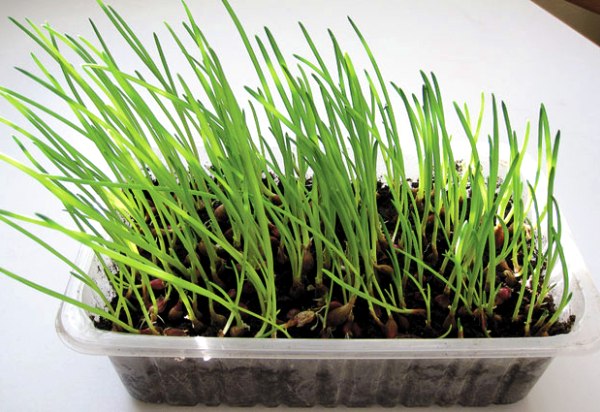
It is necessary to prepare a sapling. The process is the same as when growing green onions in water: the selected material is peeled, the bulb cuts the top by 1.5 cm, the heads are immersed in a container of hot water (+ 40 ° C). Further, the capacity must be sent for 1-2 days to the battery, giving the plant the opportunity to "wake up", this step will accelerate the growth of greenery.
Landing
Onions should be planted tightly to each other, holding it upright. Onions should not be immersed strongly in the ground, the roots should be mostly in the soil, the maximum depth is 1/3 of the bulbs.
After planting, the container with seedlings must be placed in a warm place and at a temperature not lower than + 25 ° С must be kept for 7 days. After the appearance of 1-2 sprouts seedlings are transferred to the window sill.
There is a wonderful way to grow green onions and at the same time save space on the windowsill. Resourceful gardeners for this came up with a design with the interesting name "onion cactus" or "onion tree." To translate this idea into reality you will need:
- window sill;
- priming;
- capacity for planting (bottle);
- pallet;
- planting material - onions.

The landing process is as follows:
- the neck and the bottom are cut off from the tank;
- round holes with the size equal to the planting bulb are cut along the whole container;
- the pallet is covered with earth;
- the container is placed on a pallet and covered with earth before the first circle of holes;
- bulbs are inserted into the cut circles with roots in the ground and sprinkled with earth;
- all planting actions are repeated to the top of the bottle;
- at the top, seedlings are also immersed in a vertical position.
Shine
Onions - light-loving plant, but does not tolerate heat. Ideal - when the windows are located on the south side, south-west or south-east, thus, the plants will receive a sufficient amount of light. With a lack of sunlight, it is necessary to organize additional lighting, better - fluorescent lamps.
Watering
Onions in the winter on the windowsill must be watered with warm tap water. The frequency of soil moistening is 1 time in 2 days, the main thing is to make sure that the soil does not dry out, but also not to allow excess water in order to avoid rotting of the plant roots.
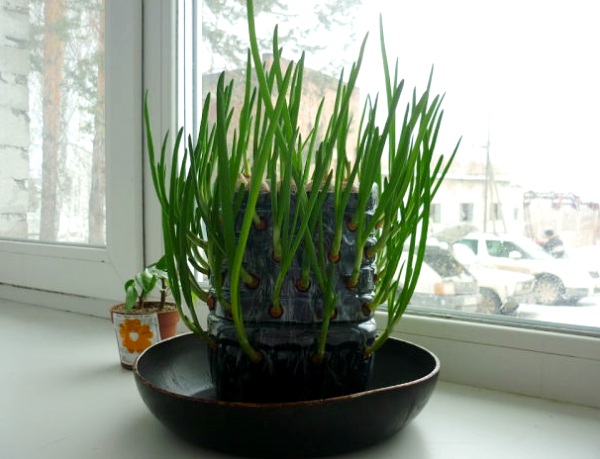
Harvesting
Experienced gardeners recommend not to cut off the first green shoots, so that green growth does not stop. The first crop is cut after 21 days. Start cutting shoots should be on the sides, leaving the central feathers intact.
Top dressing
This culture does not require feeding. However, to speed up the growth of greenery in winter, you can take 50 g of wood ash for 10 liters of water.
Temperature conditions
The optimum temperature in the room where the onions grow should not exceed + 20 ° C, otherwise the plant will wither.
Some helpful tips:
- in order to harvest continuously, it is necessary to plant in different boxes at intervals of 12-14 days;
- in order for the greens to be even, the containers with seedlings must be turned on different sides to the light.
Growing onions is not only a simple process, but also fascinating. To this case, you can safely attach children. In addition, it is useful to people of different age categories. Greens on your windowsill - the health of your family.
Video "Growing green onions at home"
In this video, the secrets of growing green onions at home: tips on choosing planting material, planting, care, harvest.
Although green onions can be bought in a supermarket both in winter and in summer, it doesn’t compare to that grown on its own window sill. First, by planting green onions at home, you can at any time pick up the necessary amount of feathers for cooking, and secondly, you will be sure that the greens were grown without the use of any harmful substances and chemicals.
Instructions on how to grow green onions at home
To achieve the greenness of the bulbs can be by forcing the pen, that is, by sprouting the roots themselves. For this is usually used onions, which you grew in your garden or bought in the store. Multi-cultivar varieties (Timiryazevsky, Spassky, Strigunovsky, Arzamas, Pograsky, Soyuz) are optimally suited. The bulbs should be about the same diameter - about 2 cm, not damaged and not sick.
cuckoo-club.ru
Prepare the soil in the container
To sprout onions at home, you can use any boxes, bowls, containers or pallets 7 cm deep. It is best to prepare two containers so that you can grow green onions in a conveyor way - then you will not have to wait until the next portion of onion feathers grows.
As a soil, you can use the ground or substrate: fine expanded clay, fine gravel, sand. The substrate should be pre-rinsed with a hot concentrated solution of potassium permanganate and running water. Fill the boxes with 3-4 cm of soil, if you have chosen a substrate, fill it with water so that it covers the surface for 1 cm. Put prepared bulbs into the ground every two centimeters, keeping them upright. Too much onion is not necessary, only roots should be in the water, otherwise the bulbs will rot.
Further care for greens
The container for a week is placed in a warm place where the temperature does not fall below +25 degrees. When the bulbs appear feathers 1-2 cm high, you should move the box on the windowsill. Ideally suited windows that overlook the south-west, south and south-east. If there is not enough sunlight, you can additionally illuminate the containers with fluorescent lamps. Only if there is enough light, green onion feathers will accumulate useful substances and acquire a rich taste.
Water the planted bulbs need warm water every other day. Ensure that the water is constantly at a level just below the surface of the substrate, and the soil does not dry out.
The first green feathers should not be cut, otherwise the further growth of greenery will stop. Cutting is done three weeks after planting the onions, and it is better to first cut off the extreme feathers, as the feather grows from the middle. In order for greens to grow continuously, the interval between plantings in different boxes should be 10-12 days.
Growing green onions in water
There is another popular way to grow onions at home without using primer. The bulbs are processed as described above and tightly laid in a vertical position on a shallow pan. Water is poured into the pan so that it closes the bulbs by a quarter. As the water level decreases, it will be necessary to pour it again. In two weeks you will get fresh green feathers, ready to eat.
Greens do not need additional fertilizing, as it takes all the useful substances during growth from the bulbs. But to accelerate the growth of feathers, you can add water with wood ash dissolved in it (10 liters 50 g).
Who doesn't love greens? Each dish is complete without the use of these products. But at the onset of winter, the difficulty in the extraction of greenery increases. How to grow green onions at home? The answer to this question can solve many problems.
Growing green onions at home is pretty simple.
Bow on the balcony
Everyone knows the facts about medicinal properties Onions, especially we need its impact on our body in the winter and early spring. Our body is exhausted in winter and did not have time to gain strength, so we need vitamins. But where to get these vitamins out of season? How to grow green onions at home, you will learn later.
First of all, it should be noted that the problem is to buy onions in the store all year round not. But we constantly think about the quality of the product. Is it possible to compare onions from your vegetable garden or window sill from what we buy in the supermarket? Since it’s not a difficult undertaking to make green onions at home, both in winter and in summer, then we should proceed.
There is nothing difficult in growing onions, but any business has its own difficulties and nuances, so you should pay attention to some points. For planting on the arrows fit the following varieties of bulbs:
- Timiryazevsky.
- Spassky.
- Strigunovsky.
- Arzamas.
- Pogramsky.
- Union
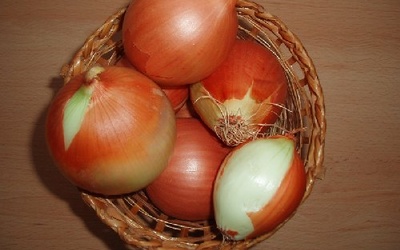
Strigunovsky bow gives good greens
The bulbs only use whole and healthy, they should be two centimeters in diameter. The selected elements are filled with hot water and put on the included battery. To continue this event must day. At the end of the event, the top brown layer is removed from the onion and inspected the selected bulbs for damage.
When done, the top of the bulb is cut. Choose a container that matches the expected event by eye. To fit there all the bulbs evenly and keep some distance between them. The depth of the tank must be at least seven centimeters.
Onions grow on the ground, or on gravel and sand. Decide on a suitable material for landing. The substrate is washed with manganese and water.
Four centimeters of soil are poured into the box, and the substrate is poured with water. The bulbs are placed with a frequency of two centimeters so that each retains a vertical position. Take care that the bulb is not deeply depressed. Waters can only touch the roots.

Onions on greens can be planted in the ground, gravel or sand
Sowing care
The box is placed in a warm place for seven days. When the feathers appear, two centimeters high-rise, the box is carried and put on the window. Give away to the south side of the windows. The bulbs should have enough light; if natural light is not enough, they are artificially illuminated.
Watering is carried out through the day so that the roots do not touch the water. Twenty-one days later, the first cut of the outermost part of the feathers can be made. Do not cut before, so that growth does not stop. Plant onions every ten or twelve days so that the crop is constant.
You can grow onions in another way, which merged no less popular. Select a shallow box and place the bulbs there vertically. Pre-process the selected onion in the same way. Water is poured into the drawer so that the fourth part of the bulb is filled with water. As water is absorbed, pour. Many who have tried this technique say that in this case feathers are formed faster.

Chives grow well without fertilizers and stimulants
Growing green onions is not difficult. He does not need a special feed. In winter, without spending much effort, you can get a generous harvest of green onions. You can plant it at any time by choosing a more suitable variety.
Many farmers argue that sevok is better suited for growing in any conditions, as sevok is a hardy variety. Green onion sevok can be planted in the same way.
Or planting and cultivation is done using seeds. Green onion seedlings are grown primarily from seeds, so the seedlings grow correctly. Sevok does not require special care, as it is unpretentious in growing.
Variety of onions and species, sevok or normal, you choose yourself. There is no significant difference in care and cultivation. Since all types are suitable for growth at home with minimal investment and time.
Green onion perfectly complements any dish. Especially in winter, when there are fewer fresh vegetables, housewives need fragrant greenery. After all, onion not only emphasizes the taste of dishes, but also contains nutrients and, with regular use in food, well replenishes the supply of vitamins and minerals in the human body.
Pros of self-growing green onions
Of course, onions can be bought in the store, even in winter. But agree that it is much more pleasant to grow it with your own hands and to always have fresh greenery at hand, in which quality and environmental friendliness you will be completely sure.

In addition, if you enjoy growing a crop throughout the year, you can easily turn the sale of green feathers into an additional or even main source of income.
Of course, it is quite difficult to grow a beam in sufficient quantity for sale in an apartment in a high-rise building. But if you are the owner home plot and the greenhouses are all in your hands. We will tell you how to grow green onions in winter.
Preparation of the country greenhouse for growing green onions
If you want to grow fragrant onions throughout the winter, then you first need to prepare for this greenhouse:
- Remove weeds and root residues from other crops.
- Air the room.
- To protect the planting from diseases, treat the soil with special disinfecting solutions or simply potassium permanganate.
- Make sure that the heating system is functioning normally and will not give off at the most inopportune moment - when the winter frosts come.
- It is very important to make sure that there are enough lamps in the greenhouse for the winter illumination of the culture, without which middle lane Russia simply can not do because of the short duration of daylight hours in winter. Experts recommend placing the fluorescent lamps vertically, then the plant will correctly form, and you will get a smooth green feather.
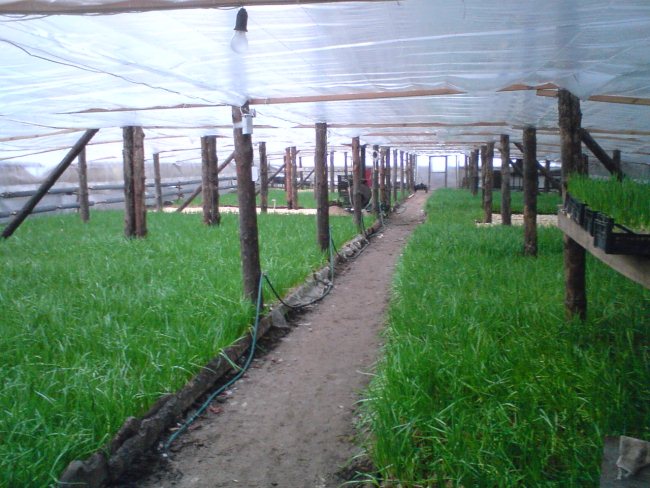
The quality of the soil for growing green onions is very important. The culture loves the “breathing” loosened soil, which is saturated with useful minerals.
In the process of preparing the soil in it is added (based on 1 square meter):
- organic fertilizer (it can be compost or manure) - 10 liters;
- mineral fertilizer (superphosphate) - 30 g;
- potassium chloride - 15 g
For those summer residents who do not have winter greenhousend fit another option. Land a bow in early-mid-October in the greenhouse ( the so-called cold greenhouse). Before the onset of frost, the plant will develop a strong root system. Cover the beds for the winter (straw or dung is suitable for this). With this method of planting in the middle of May, you can get strong and juicy feathers of green onions.
Choosing a variety of onions for the greenhouse
So, the greenhouse is prepared for the cultivation of green beds. But in order for the harvest to succeed, you need to choose the right type of crop that is suitable for growing in the season you need.
- Onions, no matter how much effort you put in to care for them, will not give a good harvest during the off-season. And the thing is that for a plant it is a period of rest and it will not develop actively.
- For landing at any time convenient for you fit such types of onions asslizun, shnitt and leek. We see them in stores all year round.
- If you want to grow onion batun, it is preferable to plant it in December.

General rules for planting onions in greenhouse soil
Green onion can be planted in two ways:
- Seedlings. To get a seedling culture, you will need seeds. Already at the end of February or at the very beginning of March they should be sown in special containers. It is very important to pre-soak the seed in clean water for 8 to 10 hours, this will help the culture to germinate faster. For soaking, use water whose temperature is +40 o C. When shoots appear, install the containers with the future seedlings in a well-lit place (if there is little natural light, install fluorescent lamps). Do not forget to water. Only in 2 months onion seedlings will be ready for planting in the greenhouse.
- Planting small bulbs. The landing pattern will depend on the season. If you are preparing to grow green feathers in the winter, the planting is carried out in October, and the planting material is placed tightly - no more than 1 cm between the bulbs. If the landing is spring, then between the plants is left to 5 cm.
Features planting individual varieties of onions
Planting leeks

This type of onion is very to the taste of gourmets: it is delicate and juicy, fresh, wonderfully complements the taste of salads and gives them a special aroma. Used in cooking the white part of the stem.
To grow this onion to your table, you need to apply the seedling method: the seeds are soaked and then planted in pots with nutritious soil mixture. Seedlings definitely need to cover the film to create a pleasant greenhouse effect for the plant. Until shoots appear, remove the film, only to moisten the soil.
Seedlings can be transplanted into the greenhouse, when there will be 2-3 leaflets on it. The ground leeches like loosened, and top dressing - from humus and wood ash.
In order for the plant to be comfortable, it is necessary to plant the seedlings in such a way that there is 10 cm between the plants. In the process of cultivation, do not forget to loosen the soil regularly to give oxygen access to the onion roots.
Planting shallots
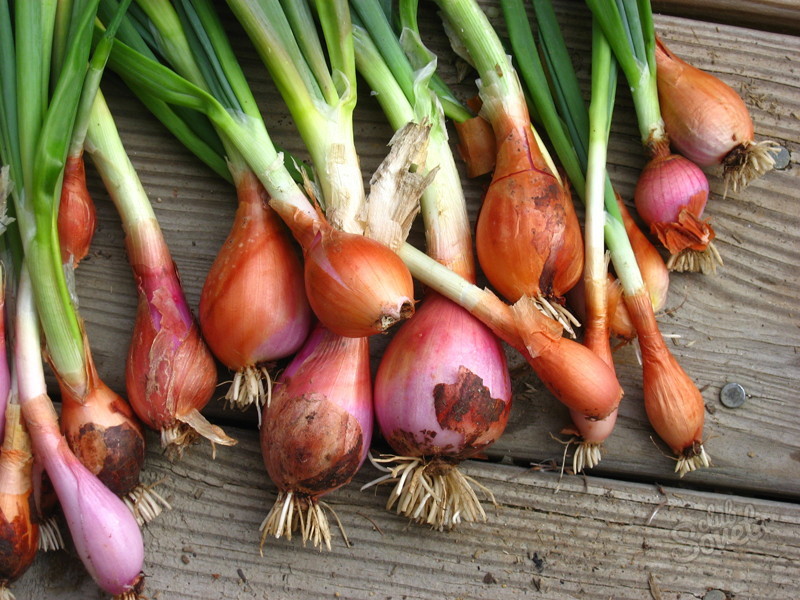
The peculiarity of this type of onion is that the onion consists of several parts (like garlic). Therefore, when planting, the onion can undoubtedly be divided, and its parts should be planted separately. However, it is very necessary to sort out the planting material: separate the rotted or diseased parts.
Experienced gardeners note that shallot varieties adapt well to the terrain. Therefore, in order not to miscalculate and get a really decent harvest, choose those varieties that are familiar to your region of residence. "Exotic" can try to grow a small batch of the sample.
Shallot can be planted in spring and autumn. Plant bulbs at a distance of 10 cm from each other, deepening the planting by 4 cm. Within a month after disembarking in the greenhouse you will receive juicy greens.
Planting onion batun
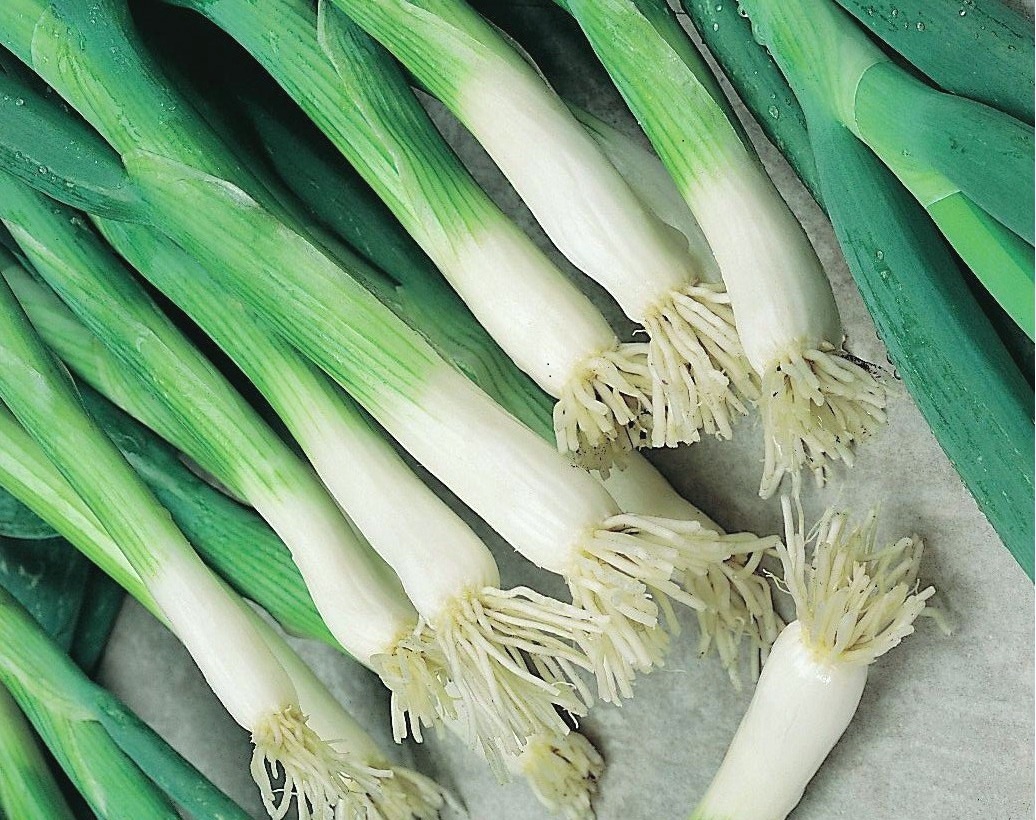
It is very appreciated among culinary specialists juicy and tender greens of the batun. In cultivation, this species of onion is not whimsical. Planting can be planted and seedlings and onions.
If you decide to grow onions from seeds, then sow it thickly (4 g per 1 square meter), then pretty soon you will get delicate feathers. However, this planting will be exclusively one-year-old: harvest, pulling the plant from the root.
How to care for green onions in the greenhouse
Simplifies the life of the dacha by the fact that the onion does not require regular fertilizing - it is enough to enrich the soil once during the preparation of the beds for planting the crop.
But for the soil moisture you have to watch all the time - any kind of onion loves water. Water the green beds not too often, but carefully. Observe the balance - excess moisture can cause bulbs to rot, then you will not have to dream about the harvest.
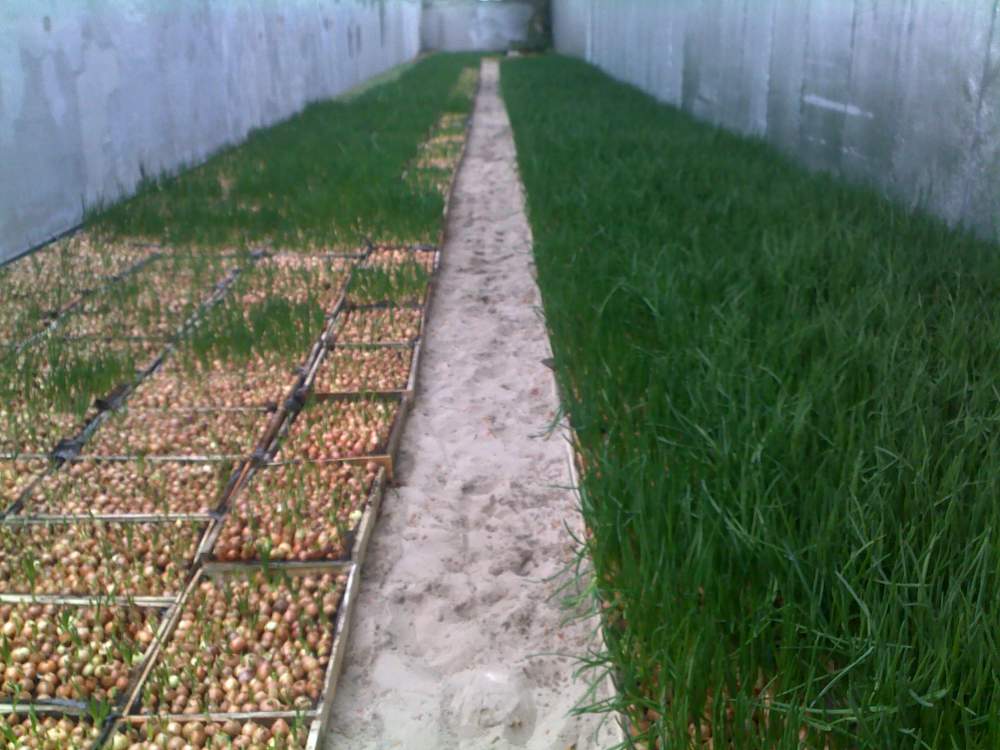
Air temperature is very important for green onions: during the day it should not be lower than 19 ° C, and at night it should not be 12 ° C. You should be especially vigilant to the gardener if the onion is grown in a winter greenhouse - control the operability of the heating system, otherwise, by freezing, the greens will immediately deteriorate.
It is necessary to air the greenhouse: this will maintain the optimum humidity of the air. However, do not expose the beds to drafts.
Taste from the vegetation of greenery attracts not only man. Unfortunately, even in the winter greenhouse, pests (insects and fungus) are also not asleep. Among common diseases of green onions mosaic and black mold. And insects are dangerous for the harvest onion fly and tobacco thrips. Watch the seedlings to notice the problem in time and fix it until all the plants are damaged. For pest control, use special products or traditional methods.
How to grow green onions at home
It would seem that it could be easier than to grow a few feathers by planting an onion in a pot of soil. But, following simple rules, you can get a real harvest of a vitamin product without any special effort.

How to prepare planting material for growing green onion house
Provide your family with fragrant greens for the winter will help you familiar to all the onions. In this case irrelevant, whether you have grown a maternal bulb on your plot or bought in the nearest supermarket.
But it is worth paying attention to the root crop variety. The best pen will give the so-called multistatic varieties, for example:
- Timiryazevsky;
- Spassky;
- "Arzamas";
- "Pogra".
Bulbs for sprouting choose small (up to 2 cm in diameter). Inspect them for damage, rot and disease - it is not worth planting damaged material.
Before boarding:
- Fold the bulbs selected for planting in a container.
- Fill with water heated to 40 ° C.
- Place in a very warm place (preferably on the battery) for 24 hours.
- When the allotted time comes out, remove the onions from the water and remove the husks from them.
- If a damaged layer is found under the husk, remove it too.
- Cut off the tips of onion tips with a sharp knife by 1–1.5 cm.
Now you can go directly to the landing.
Preparation of soil mixture for growing onions
To plant a bow, you will need a shallow container: a container, a bowl or a box 7–8 cm deep will do. If you find 2 containers for cultivation, and land a onion at different times (the second batch a couple of weeks after the first), then harvesting from one , soon you will wait for the appearance of greenery in another - fragrant greens will always be on your table.

As the soil, you can use the land from the dacha or a universal substrate bought in the store. You can add some sand to the soil - the culture will like it.
If the land was collected on the site, then it is desirable to disinfect it with a warm solution of potassium permanganate - this will eliminate the appearance of fungal diseases of the culture in the future.
- fill the prepared containers with 3-4 cm of soil mixture;
- fill with water (water should cover the soil by 1 cm);
- every 2 cm plant bulbs;
- ensure that planting material remains upright;
- no need to dig roots in the ground - only the roots should be in the soil, otherwise the bulb will start to rot.
How to care for green onions at home
Immediately after disembarking, a container with bulbs should be placed closer to the battery or in a place where the temperature will not fall below 25 ° C - this will help the culture to start growing faster. And when you notice the appearance of the first feathers 1 - 2 cm long, this will be a signal that the home bed can be moved to the window sill.

If the windows of your apartment face south or east, then there will be enough light for the bow, even in winter. But if the windows are oriented to the north, you will have to light up a little onion, so that it develops more actively and accumulates vitamins and microelements that are useful for humans in feathers. For lighting up, use a fluorescent lamp, its spectrum will fully meet the needs of the plant. Having tried one feather, you will easily understand that the culture has little light - the green will have an unexpressed taste and will not be juicy enough.
Water the "garden" to be through the day. And use warm water for this. It is important that the soil does not dry out.
Do not rush to cut the first green onion feathers - the further development of the culture may stop and there will be no rich harvest. You should wait about 20 days from the moment of landing, first start cutting off the onion. Most likely, you will not need to harvest the entire crop at once, so first use extreme feathers, and at this time the central sprouts will continue to develop.
Preparation for planting green onions in the water
If you do not have the time or desire to create improvised onion beds on your windowsill, then try growing greens in water.
To do this, select planting material (the selection is carried out in the same way as for cultivation in the substrate). Then:
- trim the selected maternal root vegetables;
- immerse them for 15-20 minutes in hot water at a temperature of about 50 o C;
- instead of water, you can use a solution of potassium permanganate to disinfect the planting material;
- after soaking hot, dip the onions immediately in cold water;
- clean the husks and remove damaged layers, if any;
- now you can land a bow in the tanks that you have prepared for this.
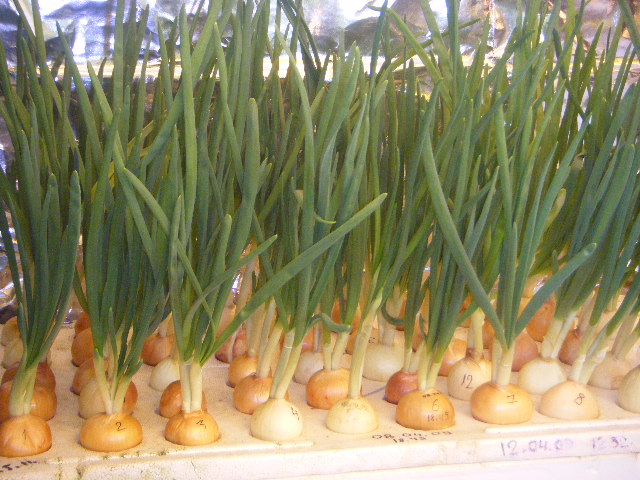
General rules for growing green onions in water
- Before planting onions, the container must be disinfected, use potassium permanganate for this.
- While the roots have not grown, put the container in a cool place and change the water twice a day.
- When the active growth of greenery begins, the water needs to be changed 1 time per day.
- If you use fertilizers to feed the “beds” - the water can be changed once a week.
- Periodically rinse the onion roots and container under running water.
The choice of capacity for growing green onions in water
In principle, you can use any container for growing greens: cans, cups, plastic containers, and even plates. The only thing that can be a problem is the onion rot. Therefore, in order for the growth process to take place correctly, it is necessary to provide the landing material is a position in which there are only roots in the water.

There are several ways:
- Plates. Pour water into a regular plate and place the onions close to each other in an upright position (the roots will support each other). The water at the bottom of the plate only concerns the roots and the lower part of the onions.
- Container. You need a plastic craft of any size and cardboard. Cut the cardboard so that it covers the sudochek and make bulb bulbs - fixture is ready. Pour water into the container, cover it with cardboard, and root the vegetables in the holes, so that they lightly touch the water.
- The cloth. If you use jars or glasses for growing onions, then this method will suit you. Wrap the onion with a cloth and place it in a glass so that the cloth touches water, and the roots of the culture do not. Then the water will rise through a damp cloth and gradually moisten the growing root crop.
- Sprinklers. If funds allow, then you can buy a special device for growing green onions at home. Onions are inserted into a special hole, water is poured into the container. Using a small compressor, the device creates a water suspension around the roots of the plant (hydroponics principle). The advantage of the germinator is that maternal onions never rot, and the feather grows very quickly - in 10 days you will get juicy greens about 15 cm long.
How to feed onions grown in water
If you want to get really good harvest on your home bed, onion is better to feed. Choose one of the compositions for feeding:
- 1.5 g ammonium nitrate, 2 g superphosphate, 1.5 g potassium chloride - all dissolved in 1 liter of pure water;
- 5 g of wood ash dilute in 1 liter of water;
- 2 tsp. mineral fertilizer (complex) dissolve in 1 l of water.
The nutrient solution needs to be made in the period when the roots appeared on the bulbs and the growth of feathers began.
Growing green onions: video
Green onions: photo
